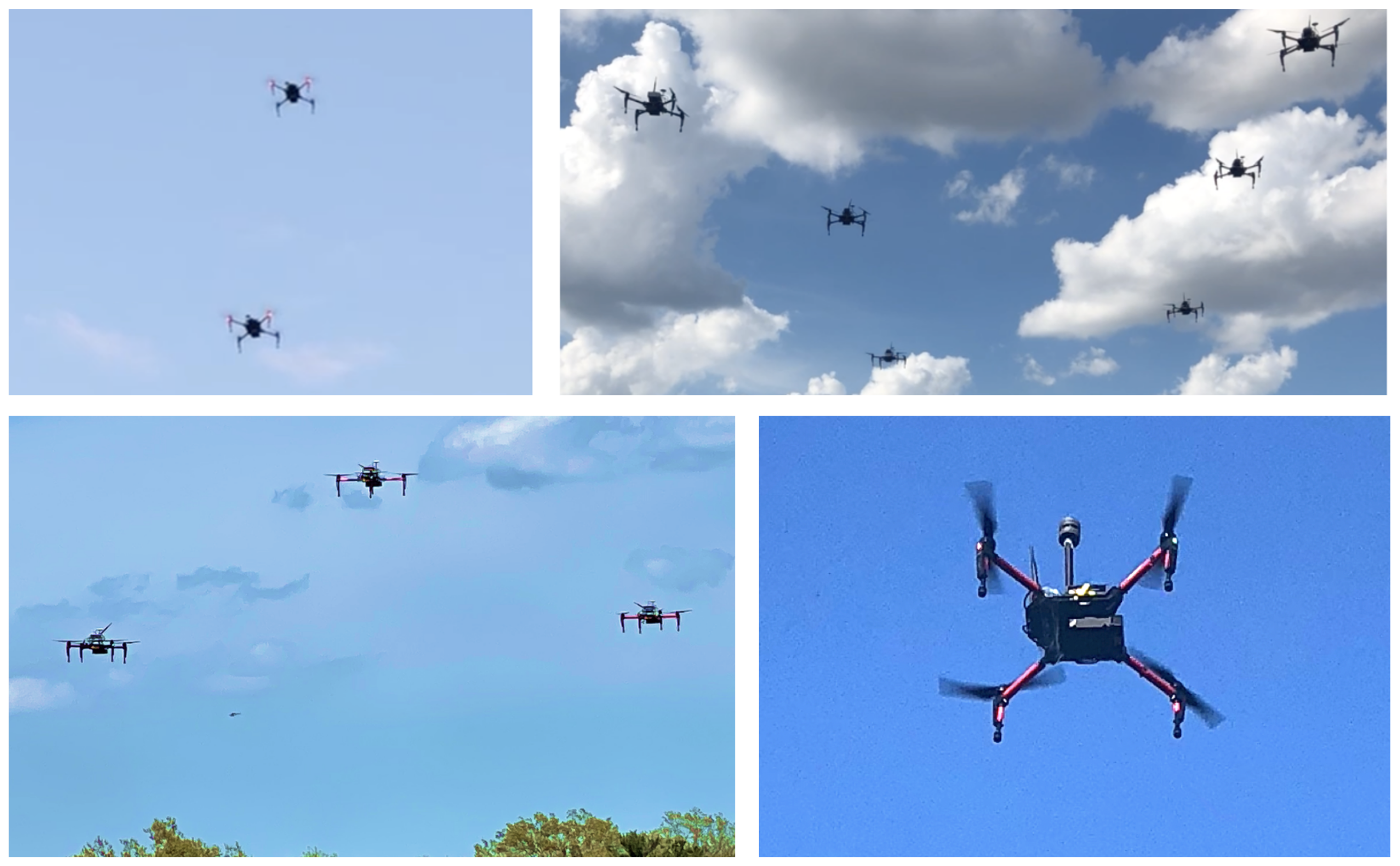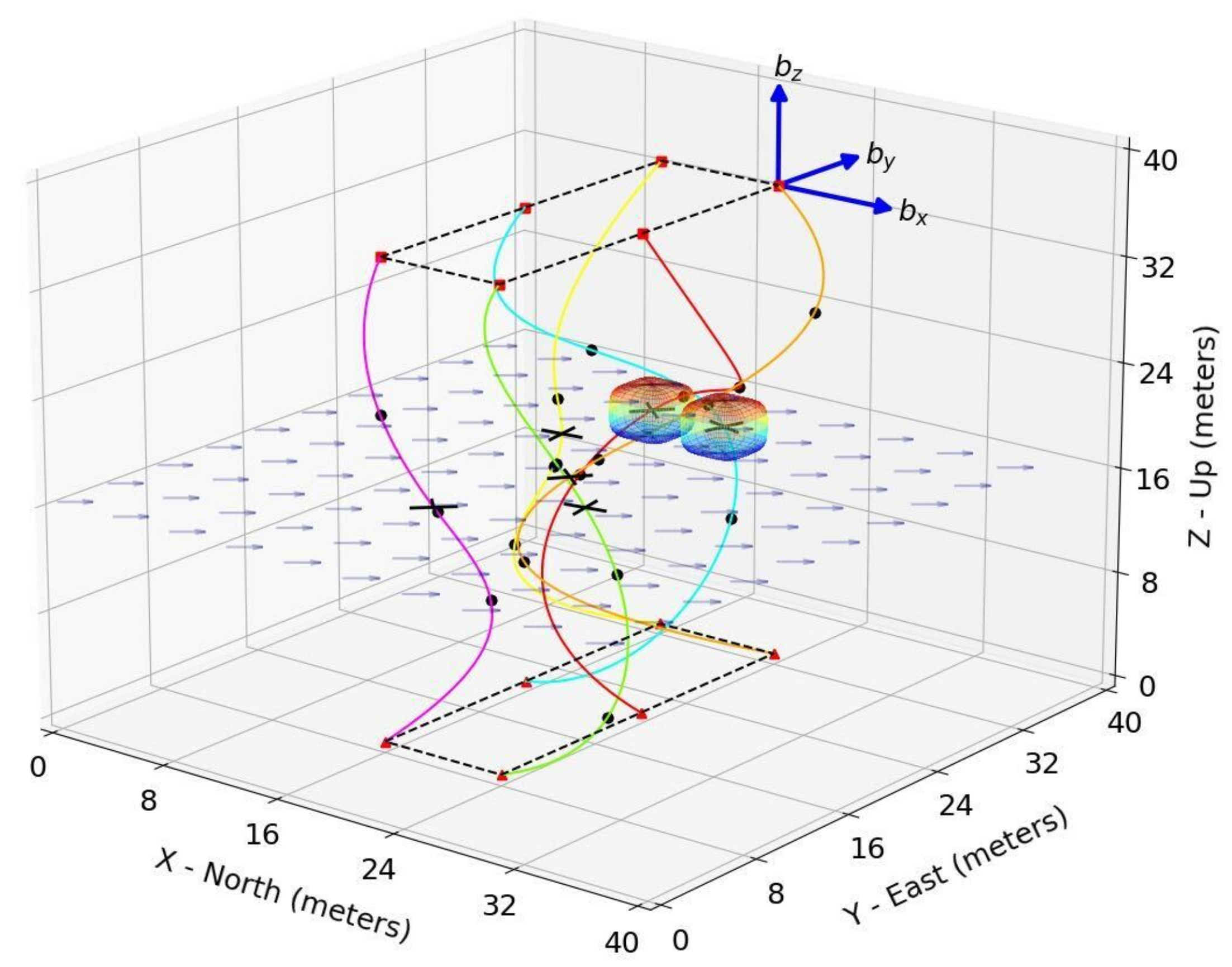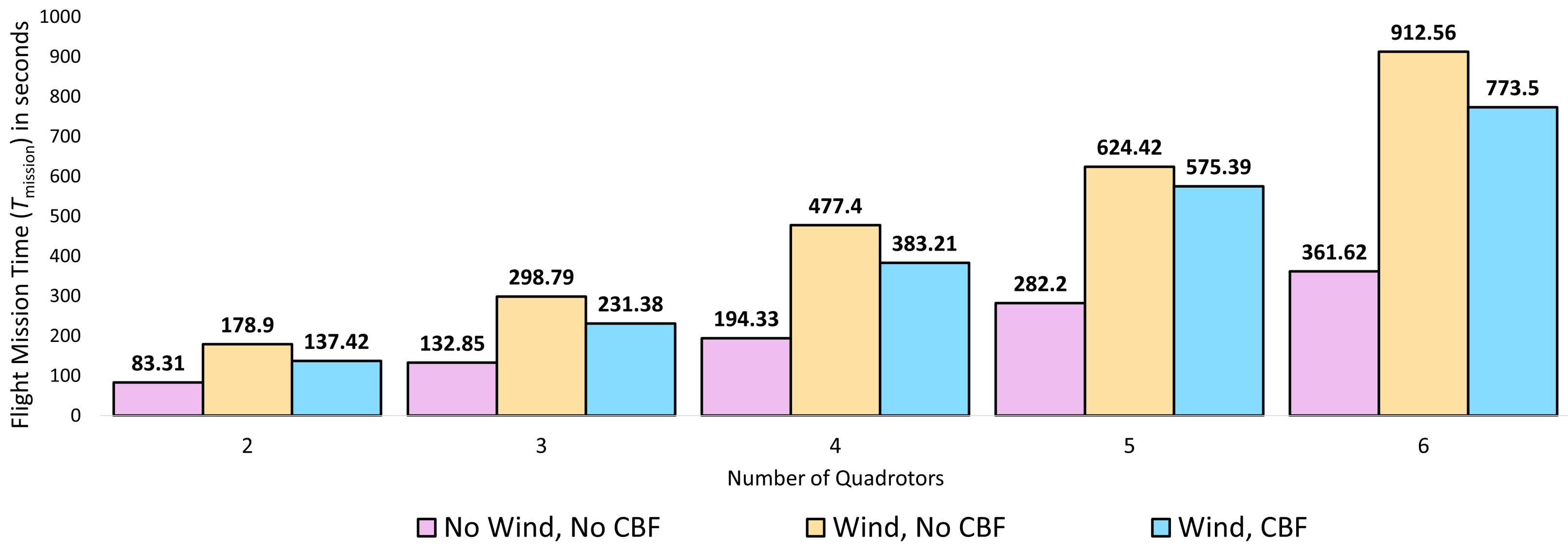Distributed Motion Planning for Multiple Quadrotors in Presence of Wind Gusts
Abstract
1. Introduction
- An RH-MINLP and CBF-based framework for real-time, MVMP of multiple, networked quadrotors, operating outdoors in the presence of wind gusts. The resulting optimization problem is solved using a fast MINLP solution approach that combines Simulated Annealing and Interior point methods.
- Real-time validation of the framework with Hardware-in-the-loop (HWIL) experiments, followed by outdoor field tests featuring up to 6 DJI M100 quadrotors.
- Integration of the Dryden wind gust model with RH-MINLP and CBFs to perform realistic simulations (featuring up to 50 quadrotors) and HWIL testing with DJI Matrice M100 quadrotors. Source code has been made available at https://github.com/radlab-sketch/ (accessed on 24 December 2022).
2. Preliminaries
2.1. Quadrotor Motion and Paths
2.2. Receding Horizon (RH)
2.3. Communication Modeling and Ordering
2.4. Dryden Wind Model and Spline Regeneration
2.5. Control Barrier Functions and Safety Barrier Certificates
3. Optimization Model
3.1. Objective Function
3.2. Path (Kinematic) Constraints
3.3. Speed and Acceleration (Dynamic) Constraint
3.4. Collision Avoidance Constraint
3.5. Communication Connectivity Constraint
4. Optimization Solution Technique
4.1. Outer Level: Distributed Decision Making
- Plans for quadrotors , as these quadrotors have already calculated their new plans, and
- Plans for quadrotors , as these quadrotors have yet to calculate their new plans.
4.2. Middle Level: Simulated Annealing for Discrete Variables and Communication Constraints
| Algorithm 1 Generating a neighbor of an incumbent solution for Simulated Annealing |
|
4.3. Lower Level: Nonlinear Optimization
5. Experimental Setup and Results
- Take-off and Formation: The quadrotors would take off one at a time and move to a preset location to organize themselves in a geometric formation. Example initial formations included a straight line, triangle, and rectangle as shown in Figure 1. The initial height of the formation was 12.5 m above ground level (AGL).
- Waypoint-based Transit: Once in formation, the quadrotors would start their transit while maintaining their flight formation, to the extent possible, and visit a total of 5 waypoints spread out across an area of 40 m × 40 m × 20 m.
- Return-To-Home (RTH): Once the quadrotors visited all the waypoints, they sequentially executed an RTH procedure to land at their take-off locations safely.
- : denotes the transit time between the start of the multiple quadrotor formation and their return to their start points averaged over multiple runs.
- : number of CBF activations averaged over multiple runs and rounded to the nearest integer.
- : Solver computation time averaged over all quadrotors, further averaged over multiple runs.
- RR: Optimization based motion-plan re-planning rate in Hz, average over multiple runs.
- : denotes the percentage of time saved when using SA instead of the BB method.
- : denotes the percentage gap in the objective function values (as defined by (4)) between BB and SA.
5.1. HWIL: Flight Safety Accorded by CBFs
5.2. HWIL: Effect of Wind Disturbances and CBFs on
5.3. Numerical Simulations for Scalability
5.4. Outdoor Flight Tests
6. Discussion
- Due to the inherent distributed nature of the decision making, certain quadrotors’ decisions may render the coordination problem difficult or infeasible to solve for other quadrotors. In some cases, reassigning a different decision order helped improve overall solutions. Safety is always maintained since the quadrotors can hover in place in case of infeasibility.
- Even when CBFs are used to provide an additional layer of assistance in collision avoidance, guaranteeing robustness to collisions is non-trivial because of the non-linearities in the multi-UAV system and unknown wind disturbances. Future work will explore the study of robust control barrier functions for constrained stabilization of the multi-UAV system, as noted in [27].
- While rare, satisfying the communication constraint can still result in network partitions. Strategies to mitigate such unusual circumstances have been developed and presented in [47].
7. Conclusions
Author Contributions
Funding
Data Availability Statement
Conflicts of Interest
References
- Causa, F.; Franzone, A.; Fasano, G. Strategic and Tactical Path Planning for Urban Air Mobility: Overview and Application to Real-World Use Cases. Drones 2023, 7, 11. [Google Scholar] [CrossRef]
- Schouwenaars, T.; De Moor, B.; Feron, E.; How, J. Mixed integer programming for multi-vehicle path planning. In Proceedings of the 2001 European Control Conference (ECC), Porto, Portugal, 4–7 September 2001; pp. 2603–2608. [Google Scholar]
- Richards, A.; How, J.P. Aircraft trajectory planning with collision avoidance using mixed integer linear programming. In Proceedings of the 2002 American Control Conference (IEEE Cat. No.CH37301), Anchorage, AK, USA, 7 November 2002; Volume 3, pp. 1936–1941. [Google Scholar]
- Rezende, A.M.; Goncalves, V.M.; Pimenta, L.C. Safe coordination of robots in cyclic paths. ISA Trans. 2021, 109, 126–140. [Google Scholar] [CrossRef] [PubMed]
- Luo, Y.; Lu, J.; Zhang, Y.; Zheng, K.; Qin, Q.; He, L.; Liu, Y. Near-Ground Delivery Drones Path Planning Design Based on BOA-TSAR Algorithm. Drones 2022, 6, 393. [Google Scholar] [CrossRef]
- Abichandani, P.; Torabi, S.; Basu, S.; Benson, H.Y. Mixed Integer Nonlinear Programming Framework for Fixed Path Coordination of Multiple Underwater Vehicles Under Acoustic Communication Constraints. IEEE J. Ocean. Eng. 2015, 40, 864–873. [Google Scholar] [CrossRef]
- Wang, T.; Lima, R.M.; Giraldi, L.; Knio, O.M. Trajectory planning for autonomous underwater vehicles in the presence of obstacles and a nonlinear flow field using mixed integer nonlinear programming. Comput. Oper. Res. 2019, 101, 55–75. [Google Scholar] [CrossRef]
- Shi, W.; Li, J.; Cheng, N.; Lyu, F.; Zhang, S.; Zhou, H.; Shen, X. Multi-drone 3-D trajectory planning and scheduling in drone-assisted radio access networks. IEEE Trans. Veh. Technol. 2019, 68, 8145–8158. [Google Scholar] [CrossRef]
- Zhao, S.; Wang, X.; Chen, H.; Wang, Y. Cooperative path following control of fixed-wing unmanned aerial vehicles with collision avoidance. J. Intell. Robot. Syst. 2020, 100, 1569–1581. [Google Scholar] [CrossRef]
- Ragi, S.; Mittelmann, H.D. Mixed-integer nonlinear programming formulation of a UAV path optimization problem. In Proceedings of the 2017 American Control Conference (ACC), Seattle, WA, USA, 24–26 May 2017; pp. 406–411. [Google Scholar]
- Abichandani, P.; Levin, K.; Bucci, D. Decentralized Formation Coordination of Multiple Quadcopters under Communication Constraints. In Proceedings of the 2019 International Conference on Robotics and Automation (ICRA), Montreal, QC, Canada, 20–24 May 2019; pp. 3326–3332. [Google Scholar]
- Kuwata, Y.; Schouwenaars, T.; Richards, A.; How, J. Robust constrained receding horizon control for trajectory planning. In Proceedings of the AIAA Guidance, Navigation, and Control Conference and Exhibit, San Francisco, CA, USA, 15–18 August 2005; p. 6079. [Google Scholar]
- Chiang, W.C.; Li, Y.; Shang, J.; Urban, T.L. Impact of drone delivery on sustainability and cost: Realizing the UAV potential through vehicle routing optimization. Appl. Energy 2019, 242, 1164–1175. [Google Scholar] [CrossRef]
- Cho, D.H.; Ha, J.S.; Lee, S.; Moon, S.; Choi, H.L. Informative path planning and mapping with multiple UAVs in wind fields. In Distributed Autonomous Robotic Systems; Springer: Berlin/Heidelberg, Germany, 2018; pp. 269–283. [Google Scholar]
- Thibbotuwawa, A.; Bocewicz, G.; Radzki, G.; Nielsen, P.; Banaszak, Z. UAV Mission Planning Resistant to Weather Uncertainty. Sensors 2020, 20, 515. [Google Scholar] [CrossRef]
- Patrikar, J.; Dugar, V.; Arcot, V.; Scherer, S. Real-time Motion Planning of Curvature Continuous Trajectories for Urban UAV Operations in Wind. In Proceedings of the 2020 International Conference on Unmanned Aircraft Systems (ICUAS), Athens, Greece, 1–4 September 2020; pp. 854–861. [Google Scholar]
- Jarray, R.; Bouallègue, S.; Rezk, H.; Al-Dhaifallah, M. Parallel Multiobjective Multiverse Optimizer for Path Planning of Unmanned Aerial Vehicles in a Dynamic Environment with Moving Obstacles. Drones 2022, 6, 385. [Google Scholar] [CrossRef]
- Military Standard. Flying Qualities of Piloted Aircraft; Technical Report MIL-STD-1797A; US Department of Defense: Fort Belvoir, VA, USA, 1990.
- Moorhouse, D.J.; Woodcock, R.J. Background Information and User Guide for MIL-F-8785C, Military Specification-Flying Qualities of Piloted Airplanes; Technical Report AFWAL-TR-81-3109; Air Force Wright Aeronautical Labs, Wright-Patterson Air Force Base: Dayton, OH, USA, 1982. [Google Scholar]
- Rodriguez, L.; Cobano, J.A.; Ollero, A. Wind field estimation and identification having shear wind and discrete gusts features with a small UAS. In Proceedings of the 2016 IEEE/RSJ International Conference on Intelligent Robots and Systems (IROS), Daejeon, Republic of Korea, 9–14 October 2016; pp. 5638–5644. [Google Scholar]
- Abichandani, P.; Lobo, D.; Ford, G.; Bucci, D.; Kam, M. Wind Measurement and Simulation Techniques in Multi-Rotor Small Unmanned Aerial Vehicles. IEEE Access 2020, 8, 54910–54927. [Google Scholar] [CrossRef]
- Ames, A.D.; Coogan, S.; Egerstedt, M.; Notomista, G.; Sreenath, K.; Tabuada, P. Control Barrier Functions: Theory and Applications. In Proceedings of the 2019 18th European Control Conference (ECC), Naples, Italy, 25–28 June 2019; pp. 3420–3431. [Google Scholar]
- Ghaffari, A. Operational Safety Control for Unmanned Aerial Vehicles Using Modular Barrier Functions. In Proceedings of the 2020 American Control Conference (ACC), Denver, CO, USA, 1–3 July 2020; pp. 1719–1724. [Google Scholar]
- Xu, B.; Sreenath, K. Safe teleoperation of dynamic UAVs through control barrier functions. In Proceedings of the 2018 IEEE International Conference on Robotics and Automation (ICRA), Brisbane, Australia, 13 September 2018; pp. 7848–7855. [Google Scholar]
- Lindemann, L.; Dimarogonas, D.V. Control barrier functions for multi-agent systems under conflicting local signal temporal logic tasks. IEEE Control Syst. Lett. 2019, 3, 757–762. [Google Scholar] [CrossRef]
- Robey, A.; Hu, H.; Lindemann, L.; Zhang, H.; Dimarogonas, D.V.; Tu, S.; Matni, N. Learning control barrier functions from expert demonstrations. In Proceedings of the 2020 59th IEEE Conference on Decision and Control (CDC), Jeju, Republic of Korea, 14–18 December 2020; pp. 3717–3724. [Google Scholar]
- Jankovic, M. Robust control barrier functions for constrained stabilization of nonlinear systems. Automatica 2018, 96, 359–367. [Google Scholar] [CrossRef]
- Israr, A.; Ali, Z.A.; Alkhammash, E.H.; Jussila, J.J. Optimization Methods Applied to Motion Planning of Unmanned Aerial Vehicles: A Review. Drones 2022, 6, 126. [Google Scholar] [CrossRef]
- Abichandani, P.; Mallory, K.; Hsieh, M.y.A. Experimental multi-vehicle path coordination under communication connectivity constraints. In Experimental Robotics; Springer Tracts in Advanced Robotics Book Series; Springer: Berlin/Heidelberg, Germany, 2013; pp. 183–197. [Google Scholar]
- Abichandani, P.; Ford, G.; Benson, H.Y.; Kam, M. Mathematical programming for multi-vehicle motion planning problems. In Proceedings of the 2012 IEEE International Conference on Robotics and Automation, Saint Paul, MN, USA, 14–18 May 2012; pp. 3315–3322. [Google Scholar]
- Mellinger, D.; Kumar, V. Minimum snap trajectory generation and control for quadrotors. In Proceedings of the 2011 IEEE International Conference on Robotics and Automation, Shanghai, China, 9–13 May 2011; pp. 2520–2525. [Google Scholar]
- Richter, C.; Bry, A.; Roy, N. Polynomial trajectory planning for aggressive quadrotor flight in dense indoor environments. In Robotics Research; Springer: Berlin/Heidelberg, Germany, 2016; pp. 649–666. [Google Scholar]
- Lepetic, M.; Klancar, G.; Skrjanc, I.; Matko, D.; Potocnik, B. Time optimal path planning considering acceleration limits. Robot. Auton. Syst. 2003, 45, 199–210. [Google Scholar] [CrossRef]
- Hakim, T.M.I.; Arifianto, O. Implementation of Dryden Continuous Turbulence Model into Simulink for LSA-02 Flight Test Simulation. J. Phys. Conf. Ser. 2018, 1005, 012017. [Google Scholar] [CrossRef]
- Lobo, D. Implementation of Dryden Wind Turbulence Model in Python, 2020, Source Code. Available online: https://github.com/radlab-sketch/drydenModelPython (accessed on 24 December 2022).
- Wang, L.; Ames, A.D.; Egerstedt, M. Safe certificate-based maneuvers for teams of quadrotors using differential flatness. In Proceedings of the 2017 IEEE International Conference on Robotics and Automation (ICRA), Singapore, 29 May–3 June 2017; pp. 3293–3298. [Google Scholar]
- Potra, F.A.; Wright, S.J. Interior-point methods. J. Comput. Appl. Math. 2000, 124, 281–302. [Google Scholar] [CrossRef]
- Benson, H.Y.; Shanno, D.F. Interior-Point Methods for Nonconvex Nonlinear Programming: Regularization and Warmstarts. Comput. Optim. Appl. 2008, 40, 143–189. [Google Scholar] [CrossRef]
- Bonami, P.; Lodi, A.; Tramontani, A.; Wiese, S. On mathematical programming with indicator constraints. Math. Program. 2015, 151, 191–223. [Google Scholar] [CrossRef]
- Lee, J.; Leyffer, S. Mixed Integer Nonlinear Programming; Springer Science & Business Media: Berlin/Heidelberg, Germany, 2011; Volume 154. [Google Scholar]
- Liberti, L.; Sager, S.; Wiegele, A. Mixed-integer Nonlinear Optimization: A hatchery for modern mathematics. Oberwolfach Rep. 2020, 16, 1573–1637. [Google Scholar] [CrossRef]
- Kirkpatrick, S.; Gelatt, C.D., Jr.; Vecchi, M.P. Optimization by simulated annealing. Science 1983, 220, 671–680. [Google Scholar] [CrossRef] [PubMed]
- Cardoso, M.; Salcedo, R.; De Azevedo, S.F.; Barbosa, D. A simulated annealing approach to the solution of MINLP problems. Comput. Chem. Eng. 1997, 21, 1349–1364. [Google Scholar] [CrossRef]
- Wei-zhong, A.; Xi-Gang, Y. A simulated annealing-based approach to the optimal synthesis of heat-integrated distillation sequences. Comput. Chem. Eng. 2009, 33, 199–212. [Google Scholar] [CrossRef]
- Shanno, D.; Vanderbei, R. Interior-Point Methods for Nonconvex Nonlinear Programming: Orderings and Higher-Order Methods. Math. Prog. 2000, 87, 303–316. [Google Scholar] [CrossRef]
- Matrice 100 TB48D Battery. Available online: https://store.dji.com/product/matrice-100-tb48d-battery (accessed on 5 January 2023).
- Abichandani, P.; Benson, H.Y.; Kam, M. Multi-vehicle path coordination in support of communication. In Proceedings of the 2009 IEEE International Conference on Robotics and Automation, Kobe, Japan, 12–17 May 2009; pp. 3237–3244. [Google Scholar]
- Qin, Z.; Zhang, K.; Chen, Y.; Chen, J.; Fan, C. Learning Safe Multi-agent Control with Decentralized Neural Barrier Certificates. arXiv 2021, arXiv:2101.05436. [Google Scholar]




| 3 m | 0 | 0.5 m/s | |||
| −0.25 m/s | 0.25 m/s | 1 | |||
| 5 m | 100 mW | 3 |
| n | SA | BB | ||||
|---|---|---|---|---|---|---|
| 10 | 132.3 | 14 | 195.2 | 16 | 47.54% | −5.29% |
| 15 | 186.8 | 17 | 311.9 | 19 | 66.97% | −4.66% |
| 20 | 271.1 | 19 | 648.5 | 18 | 139.21% | 0.2% |
| 25 | 383.9 | 22 | 902.4 | 21 | 135.06% | −3.10% |
| 30 | 562.1 | 27 | 1376.2 | 30 | 144.83% | −1.98% |
| 40 | 819.3 | 31 | 2314.7 | 31 | 182.52%. | −7.81% |
| 50 | 1184.5 | 38 | 3920.7 | 42 | 231% | −6.52% |
| n | Wind Speed (mean, stdev) (m/s) | (s) | (ms) | RR (Hz) | |
|---|---|---|---|---|---|
| 2 | 12.23, 3.49 | 141.52 | 1 | 26.8 | 30 |
| 3 | 10.33, 1.54 | 258.10 | 2 | 37.2 | 24 |
| 6 | 13.5, 2.0 | 829.47 | 4 | 74.6 | 12 |
Disclaimer/Publisher’s Note: The statements, opinions and data contained in all publications are solely those of the individual author(s) and contributor(s) and not of MDPI and/or the editor(s). MDPI and/or the editor(s) disclaim responsibility for any injury to people or property resulting from any ideas, methods, instructions or products referred to in the content. |
© 2023 by the authors. Licensee MDPI, Basel, Switzerland. This article is an open access article distributed under the terms and conditions of the Creative Commons Attribution (CC BY) license (https://creativecommons.org/licenses/by/4.0/).
Share and Cite
Abichandani, P.; Lobo, D.; Muralidharan, M.; Runk, N.; McIntyre, W.; Bucci, D.; Benson, H. Distributed Motion Planning for Multiple Quadrotors in Presence of Wind Gusts. Drones 2023, 7, 58. https://doi.org/10.3390/drones7010058
Abichandani P, Lobo D, Muralidharan M, Runk N, McIntyre W, Bucci D, Benson H. Distributed Motion Planning for Multiple Quadrotors in Presence of Wind Gusts. Drones. 2023; 7(1):58. https://doi.org/10.3390/drones7010058
Chicago/Turabian StyleAbichandani, Pramod, Deepan Lobo, Meghna Muralidharan, Nathan Runk, William McIntyre, Donald Bucci, and Hande Benson. 2023. "Distributed Motion Planning for Multiple Quadrotors in Presence of Wind Gusts" Drones 7, no. 1: 58. https://doi.org/10.3390/drones7010058
APA StyleAbichandani, P., Lobo, D., Muralidharan, M., Runk, N., McIntyre, W., Bucci, D., & Benson, H. (2023). Distributed Motion Planning for Multiple Quadrotors in Presence of Wind Gusts. Drones, 7(1), 58. https://doi.org/10.3390/drones7010058





